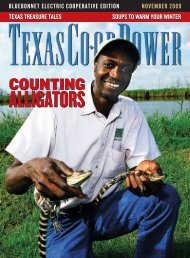OFF TO THE RACES - Bluebonnet Electric Cooperative
OFF TO THE RACES - Bluebonnet Electric Cooperative
OFF TO THE RACES - Bluebonnet Electric Cooperative
Create successful ePaper yourself
Turn your PDF publications into a flip-book with our unique Google optimized e-Paper software.
Up, up and away: Time after time, logic-defying flights bring pigeons, the thoroughbreds of the sky, safely back home.<br />
Off<br />
theRaces<br />
to<br />
BY HELEN CORDES • PHO<strong>TO</strong>S BY WILL VAN OVERBEEK<br />
As Jim Keng stood sentry, scanning the skies from his<br />
patio in La Porte, he had a healthy hunch that Miss Elite<br />
would be the first bird home. Sure enough, the petite,<br />
1-pound pigeon made a final circle above Keng’s backyard,<br />
swooped smoothly onto the stoop, and walked calmly back<br />
into a pigeon loft.<br />
Miss Elite had just wrapped up a mind-boggling feat: She<br />
Nobody knows for sure how racing pigeons find their way home. But there’s<br />
little mystery as to why pigeons would want to return to this airy, spacious<br />
building built by Harry Rauch that looks more like a guesthouse than a birdhouse.<br />
Rauch, a Guadalupe Valley <strong>Electric</strong> <strong>Cooperative</strong> member, provides his<br />
birds special grain mixes and weekly baths to keep their feathers primed for<br />
flight. Research suggests that pigeons navigate their way home by using the<br />
sun's position and Earth's magnetic field as a compass. They also rely on a<br />
keen sense of sight, smell and sound.<br />
8 TEXAS CO-OP POWER July 2011<br />
flew 10 hours straight, at 50 mph, from 500 miles away in<br />
Hoxie, Arkansas. With her uncanny internal GPS and singleminded<br />
determination, she made a beeline for one tiny speck<br />
in a semirural neighborhood just east of Houston.<br />
Every time Miss Elite arrives home from the long-distance<br />
races she’s aced to earn elite-flier status, “she still looks like a<br />
million bucks,” says Keng, an affable general contractor who’s<br />
president of the Texas Center of Racing Pigeon Clubs.<br />
For Keng and the other 400 or so pigeon racers in Texas,<br />
moments like Miss Elite’s quiet triumph are unforgettable.<br />
It’s the payoff for pampering the pigeons from egg to birth<br />
and beyond, patiently training them day after day to carry<br />
out their ancestral mission of flying home—fast. For many<br />
owners of these so-called thoroughbreds of the sky, it’s all<br />
part of a thrilling high-stakes sport that pits top fliers for<br />
lucrative purses at races like the annual Texas Showdown<br />
and Texas Gusher, two of the state’s top pigeon competitions.<br />
For the rest of us, it’s an astounding reminder of the abilities<br />
of pigeons to perform jaw-dropping feats while carrying<br />
on one of the world’s oldest methods of communication.<br />
“The Romans and Greeks used pigeons widely to carry<br />
messages,” enthuses Bulverde’s Robert Tomlinson, a pigeon<br />
racer and former executive vice president of the Oklahoma<br />
City-based American Racing Pigeon Union, which has close<br />
to 700 clubs and 10,000 members. For centuries, pigeons<br />
provided postal services—everywhere from a fully birdstaffed<br />
service in 12th century Baghdad, Iraq, all the way up<br />
to India’s Police Pigeon Service, an 800-bird “P-mail” service<br />
for emergency messages that was used until 2002.






